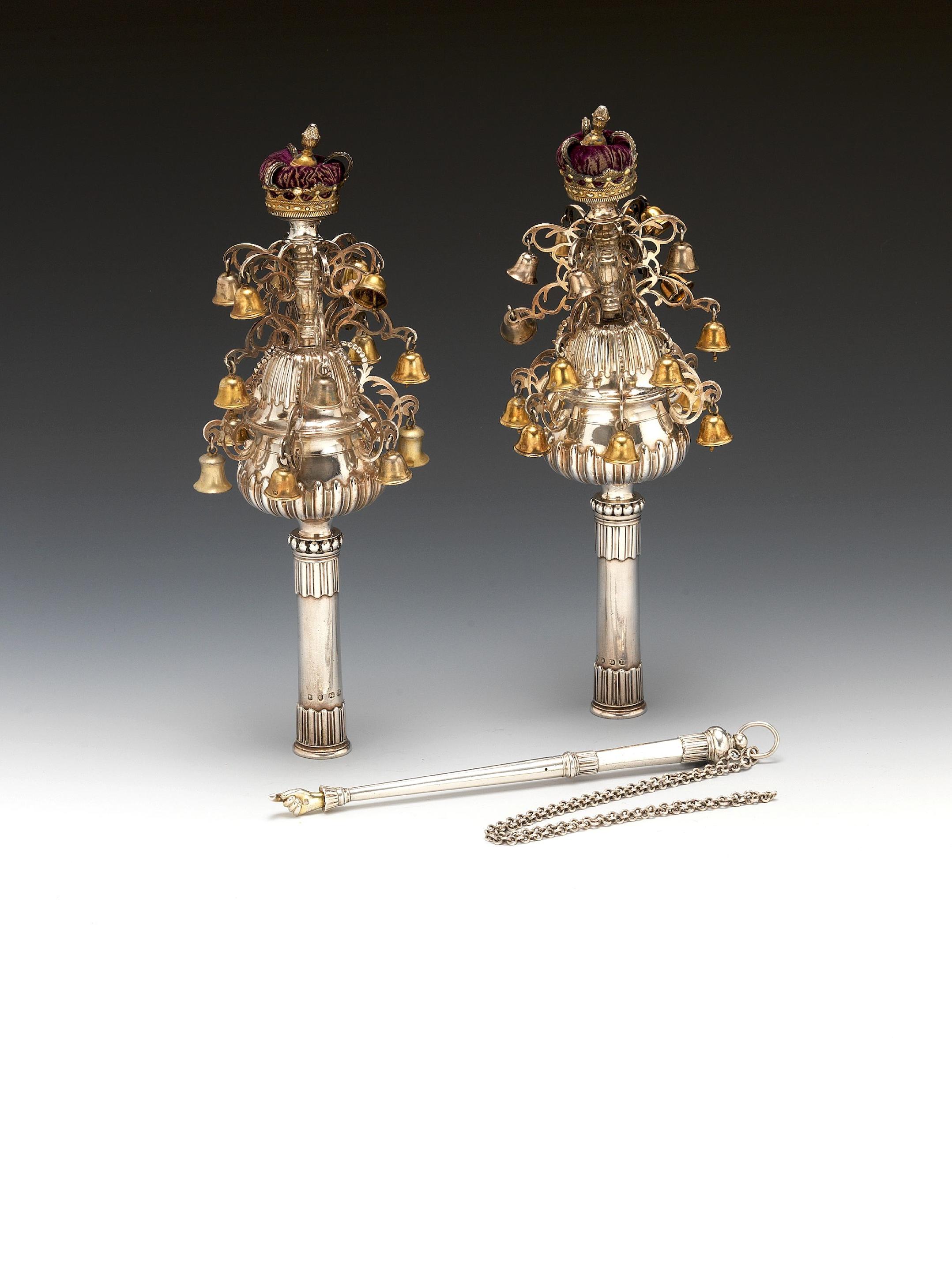A Highly Important Torah Ark Curtain, Ottoman Empire or Italy, 19th century
This sumptuous, lavishly embroidered Torah ark curtain features two iconic motifs found on Torah ark curtains created in the Ottoman Empire: the portal motif and the hanging lamp motif. Both of these images were originally drawn from the designs of Islamic prayer rugs but were “Judaized” with the inclusion of Jewish elements such as verses from the Bible and Judaic images like the Star of David seen at the top of this curtain. The portal motif was adopted for use on Torah ark curtains as it connects the worshipper to several relevant biblical verses, for example, “Open the gates of righteousness for me that I may enter them and praise the Lord” (Ps. 118:19). As seen here, the image of the hanging lamp always appears together with the image of the portal in the design of Torah ark curtains from the Ottoman Empire and apparently represents the Eternal Light that hangs in the synagogue. The extremely talented artisan who created this masterpiece employed many different types of stitches and embroidery techniques, including couching, plaited braid stitch, lattice stitch, stem stitch, and stumpwork.
The scholar Esther Juhasz has pointed out that a very small group of silk Torah ark curtains, which employ this same imagery of a portal coupled with a large hanging lamp, display techniques that may indicate that they were created in Italy based on the design of curtains from the Ottoman Empire. However, Dr. Vivian Mann, in her publications, has localized this same small group of silk embroidered Torah ark curtains to Turkey. It is clear that the present textile, which is the most splendid example of this group, constitutes striking evidence of the mutual influences and close connections between the Jewish communities of Italy and the Ottoman Empire fostered by continuous mercantile activity. Future scholarship may help determine whether it was created in Italy for use in the Ottoman Empire; in Italy for use in a local synagogue of Ottoman Jews; or in the Ottoman Empire using embroidery techniques more closely associated with Italian Torah ark curtains.
Physical DescriptionSilk satin with a metallic fringe along the outer edge, silver and gilt metallic threads, and appliquéd flowers constructed from a variety of silks and paillettes (76 x 49 in.; 1930 x 1245 mm).
LiteratureEsther Juhasz (ed.), Sephardi Jews in the Ottoman Empire: Aspects of Material Culture (Jerusalem: The Israel Museum, 1990), 65-119.
Vivian B. Mann, A Tale of Two Cities: Jewish Life in Frankfurt and Istanbul, 1750-1870 (New York: The Jewish Museum, 1982), 158-159.
Bracha Yaniv, Ceremonial Synagogue Textiles: From Ashkenazi, Sephardi, and Italian Communities, trans. Yohai Goell (London: The Littman Library of Jewish Civilization, 2019), 193-252.
A Highly Important Torah Ark Curtain, Ottoman Empire or Italy, 19th century
This sumptuous, lavishly embroidered Torah ark curtain features two iconic motifs found on Torah ark curtains created in the Ottoman Empire: the portal motif and the hanging lamp motif. Both of these images were originally drawn from the designs of Islamic prayer rugs but were “Judaized” with the inclusion of Jewish elements such as verses from the Bible and Judaic images like the Star of David seen at the top of this curtain. The portal motif was adopted for use on Torah ark curtains as it connects the worshipper to several relevant biblical verses, for example, “Open the gates of righteousness for me that I may enter them and praise the Lord” (Ps. 118:19). As seen here, the image of the hanging lamp always appears together with the image of the portal in the design of Torah ark curtains from the Ottoman Empire and apparently represents the Eternal Light that hangs in the synagogue. The extremely talented artisan who created this masterpiece employed many different types of stitches and embroidery techniques, including couching, plaited braid stitch, lattice stitch, stem stitch, and stumpwork.
The scholar Esther Juhasz has pointed out that a very small group of silk Torah ark curtains, which employ this same imagery of a portal coupled with a large hanging lamp, display techniques that may indicate that they were created in Italy based on the design of curtains from the Ottoman Empire. However, Dr. Vivian Mann, in her publications, has localized this same small group of silk embroidered Torah ark curtains to Turkey. It is clear that the present textile, which is the most splendid example of this group, constitutes striking evidence of the mutual influences and close connections between the Jewish communities of Italy and the Ottoman Empire fostered by continuous mercantile activity. Future scholarship may help determine whether it was created in Italy for use in the Ottoman Empire; in Italy for use in a local synagogue of Ottoman Jews; or in the Ottoman Empire using embroidery techniques more closely associated with Italian Torah ark curtains.
Physical DescriptionSilk satin with a metallic fringe along the outer edge, silver and gilt metallic threads, and appliquéd flowers constructed from a variety of silks and paillettes (76 x 49 in.; 1930 x 1245 mm).
LiteratureEsther Juhasz (ed.), Sephardi Jews in the Ottoman Empire: Aspects of Material Culture (Jerusalem: The Israel Museum, 1990), 65-119.
Vivian B. Mann, A Tale of Two Cities: Jewish Life in Frankfurt and Istanbul, 1750-1870 (New York: The Jewish Museum, 1982), 158-159.
Bracha Yaniv, Ceremonial Synagogue Textiles: From Ashkenazi, Sephardi, and Italian Communities, trans. Yohai Goell (London: The Littman Library of Jewish Civilization, 2019), 193-252.















Testen Sie LotSearch und seine Premium-Features 7 Tage - ohne Kosten!
Lassen Sie sich automatisch über neue Objekte in kommenden Auktionen benachrichtigen.
Suchauftrag anlegen